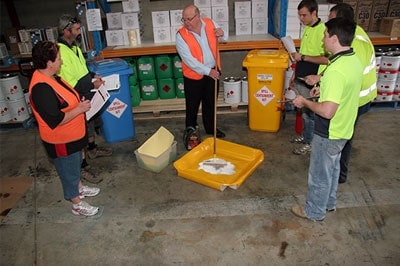Effective Workplace Spill Response in 4 Steps

Chemicals are present in many workplaces, from laboratories to office environments. Chemicals are hazardous and can be deadly when misused or in the case of an incident.
Chemical use ranges from one workplace to the next. Some chemicals are for production. Others are for cleaning purposes. They can also be to lubricate equipment or to ease some other workplace action.
Chemicals can be toxic, flammable, oxidising or reactive. They can lead to damaging scenarios for staff, equipment/resources, and facilities. Spill response training is crucial. In this article, we’ll be sharing with you 4 essential steps to take if a chemical spill occurs.
HOW DANGEROUS IS A SPILL?
There are various contributing factors to the level of danger a spill presents. Of course, the material spilled is a major contributor. But you must also consider the following factors:
- How much spilt
- Where it spilt
- What surface it spilt on
- What ventilation exists where it spilt
- The temperature of the spill site
Depending on the nature of the spill, evacuation may be required. The availability of spill kit supplies and PPE are the employer’s responsibility. They should be specific to the chemicals that exist and/or are handled in their workplace.
4 STEPS TO WORKPLACE SPILL RESPONSE
Best practice workplace spill response follows 4 simple steps. Specifics, including the role responsible for each step, might vary from workplace to workplace. But, the 4 steps below will shape the foundation of workplace spill response.
1. COMMUNICATION
Communicate the hazard immediately regardless of the severity. Other staff working in the area and those in supervisory roles need to be notified. If warranted, evacuate the area and follow emergency procedures, i.e. calling 000. In the case of this, communicate what spilt and how much of it to the dispatcher. This is so that appropriate action can be taken by first responders quickly after their arrival on site.
2. CONTROL
Once the spill has been communicated to the appropriate parties, control it. Take measures to stop or reduce the impact of the spill. This involves closing valves and putting a tipped over container the right way up, for example. Depending on the chemical nature and severity of the spill, this step may need PPE. For example, respiratory protection.
If required, shut down heat sources or any possible sources of ignition. To diffuse fumes, increase ventilation to the area of concern. Unless the fumes are a hazard themselves, in which case isolate the area. This can be done by shutting vents, windows, and doors (after evacuation).
3. CONTAIN
By now the immediate situation would have been taken care of. So, now it’s time to contain the spill. This step involves ensuring the spill doesn’t contaminate neighbouring areas. Prevent the spill from spreading to drains or flowing into environmentally sensitive areas.
Depending on what spilt, you can contain it by using absorbent mats or neutralisers. Spread them around the boundary of the spill and then work them into the centre of it. Some situations will need a dike to be built or a spill sock to be used in the blocking or directing of the spillage.
If during the process you need to leave the area of concern, block access to the spillage. Do this with caution tape or some other barrier so that other people in the workplace don’t come into contact with it.
4. CLEAN-UP
The final step in the 4-part spill response process is the clean-up. Dispose of any absorbent mats and other neutralising materials. Rubbish bags or pails/drums can be used for this, depending on the size of the spill.
Sometimes the nature of the spill will mean that any brooms, brushes, pans or other equipment used to clean-up to be disposed of too. If it is a hazardous material that is being disposed of, do so in line with the local environmental law and regulation. This includes labelling before disposal.
Wash any affected surfaces with the correct solution for the spill at hand. This could be, for example, detergent, water or bleach. Hands, clothes and any other areas that have been in contact with the spilled material may also need decontamination.
Related article: A Quick Guide to Chemical Spill Response and Procedures
PREVENTION IS KEY
Whilst there are the above 4-steps to deal with chemical spills, the best way forward is to avoid them all together! There are many procedures in place for working with chemicals. This involves procedures for storing them, moving, using and disposing of them. Ensure staff are trained to be able to follow these procedures, as well as the spill response steps.
Material safety data sheets should be easily accessible for each chemical on site. Employees who work with chemicals must be provided with the PPE and make use of it accordingly.
SPILL RESPONSE TRAINING
The demands of regulation have recently increased. As a result, businesses face hefty fines for non-compliance. Ecospill has a range of spill response training courses. They can assist you in meeting your environmental obligations.
Their trainers lead the way in skill kits training with over 10 years’ industry experience. The participants of the spill training courses will develop their skills through theory and practice. The courses focus on spill prevention, containment and clean-up.
FINAL WORDS
Inherent risk is minimised when chemicals are appropriately handled and stored. But, in the case of chemical spillage, quick and effective action can reduce damage and injury.
This highlights the significance of ongoing staff training. They must be sound on chemical use and response to workplace spills.
Having a chemical spill plan is also important. This will ensure a smooth and safe response to any spills. The structure of the plan will depend on which chemicals are present at your workplace and how staff are exposed to them. But it should roughly follow the 4-steps we have discussed here.
